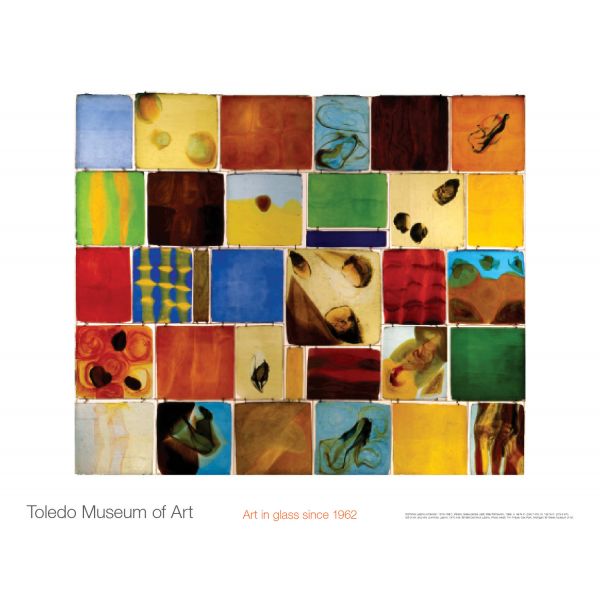Dominick Labino "Vitrana" Print
$25.00
Availability:
In stock
SKU
024666
Poster Size: 22" x 28"
In 1969 the Toledo Museum of Art opened a new gallery dedicated to its comprehensive collection of art in glass (the collection is now housed in the Glass Pavilion). As a focal point for this new gallery, the Museum commissioned glass artist Dominick Labino to create a mural of glass to be placed at the gallery's entrance (it, too, now resides in the Glass Pavilion). Labino's particular interest and expertise lay in expanding the range of colors and the variety of color effects possible in the creation of glass art. While Vice-President and Director of Research at Johns-Manville Fiber Glass, Inc. in Toledo, Labino had been invited by his friend Harvey Littleton to contribute his technical expertise to the Toledo Workshops in 1962—the seminal experiments in glassworking with small furnaces that led to the Studio Glass movement (see 1992.41a-l). In 1965 Labino retired from Johns-Manville to pursue a full-time career as a glass artist.
In order to carry out his vision for Vitrana, Labino had to develop a special annealing oven to allow for slow cooling of the glass panels, many of which consisted of different types of glass with different chemical compositions that created the color combinations and veiling effects he desired. As Labino recalled, "As each new panel was taken from the annealing oven, the experience of viewing and selecting became each day more exciting."
Held in place by metal pins bolted to a steel frame and lit by concealed lights at the base and sides, the thirty-three flat, rectangular panels appear to be floating in space, the entire mural a play of color, light, and design in glass.
Dominick Labino (American, 1910-1987), Vitrana. Glass Panels, cast; steel framework, 1969. H. 96 3/4 in. (245.7 cm); W. 108 3/8 in. (275.3 cm). Gift of Mr. and Mrs. Dominick Labino, 1970.449. © 1969 Dominick Labino. Photo credit: Tim Thayer, Oak Park, Michigan. © Toledo Museum of Art
In 1969 the Toledo Museum of Art opened a new gallery dedicated to its comprehensive collection of art in glass (the collection is now housed in the Glass Pavilion). As a focal point for this new gallery, the Museum commissioned glass artist Dominick Labino to create a mural of glass to be placed at the gallery's entrance (it, too, now resides in the Glass Pavilion). Labino's particular interest and expertise lay in expanding the range of colors and the variety of color effects possible in the creation of glass art. While Vice-President and Director of Research at Johns-Manville Fiber Glass, Inc. in Toledo, Labino had been invited by his friend Harvey Littleton to contribute his technical expertise to the Toledo Workshops in 1962—the seminal experiments in glassworking with small furnaces that led to the Studio Glass movement (see 1992.41a-l). In 1965 Labino retired from Johns-Manville to pursue a full-time career as a glass artist.
In order to carry out his vision for Vitrana, Labino had to develop a special annealing oven to allow for slow cooling of the glass panels, many of which consisted of different types of glass with different chemical compositions that created the color combinations and veiling effects he desired. As Labino recalled, "As each new panel was taken from the annealing oven, the experience of viewing and selecting became each day more exciting."
Held in place by metal pins bolted to a steel frame and lit by concealed lights at the base and sides, the thirty-three flat, rectangular panels appear to be floating in space, the entire mural a play of color, light, and design in glass.
Dominick Labino (American, 1910-1987), Vitrana. Glass Panels, cast; steel framework, 1969. H. 96 3/4 in. (245.7 cm); W. 108 3/8 in. (275.3 cm). Gift of Mr. and Mrs. Dominick Labino, 1970.449. © 1969 Dominick Labino. Photo credit: Tim Thayer, Oak Park, Michigan. © Toledo Museum of Art
Write Your Own Review




